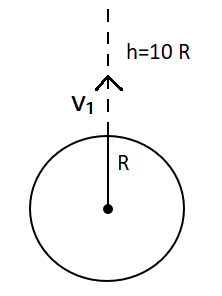
The initial velocity \[{v_i}\] required to project a body vertically upward from the surface of the earth to just reach a height of 10R, where R is the radius of the earth, may be described in terms of escape velocity \[{v_e}\] such that \[{v_i} = \sqrt {\left( {\dfrac{x}{y}} \right)} {v_e}\]. The value of x will be_______.
Answer
217.5k+ views
Hint:The energy acquired by an object due to the change in its position when it is present in a gravitational field is known as gravitational potential energy. If the body is taken from the surface of the earth to a point at a height h above the surface of the earth then the total distance will be the sum of the height and radius of the earth.
Formula used:
Potential energy at the surface of the earth is given by,
\[U = - \dfrac{{GMm}}{R}\]
Where G is the gravitational constant, \[M\] is the source mass and \[m\] is test mass at
R is the radius of the earth.
Potential energy at some height h from the earth is given by,
\[{U_h} = \dfrac{{GMm}}{{R + h}}\]
Where h is height vertically upward from the surface of the earth.
Complete step by step solution:
Given: Height = 10R where R is the radius of the earth

Image: Object is projected from the surface of earth reaches a height of 10R.
Total energy before projection of a body,
\[\begin{array}{l}{E_i} = PE(U) + KE\\{\rm{ = - }}\dfrac{{GMm}}{R} + \dfrac{1}{2}m{v_i}^2\end{array}\]
Total energy after projection of a body,
\[\begin{array}{l}{E_f} = PE({U_h}) + KE\\{\rm{ = - }}\dfrac{{GMm}}{{R + h}} + 0\\{\rm{ = - }}\dfrac{{GMm}}{{11R}} + 0\end{array}\]
(Kinetic energy at the surface becomes zero)
Now by law of conservation of energy, we get
\[ - \dfrac{{GMm}}{R} + \dfrac{1}{2}m{v_i}^2 = - \dfrac{{GMm}}{{11R}} + 0\]
\[\Rightarrow {v_i}^2 = \dfrac{{20GM}}{{11R}}\]
\[\Rightarrow {v_i} = \sqrt {\dfrac{{20GM}}{{11R}}} \]
As we know escape velocity, \[{v_e} = \dfrac{{GM}}{R}\]
By using this in above
\[{v_i} = \sqrt {\dfrac{{20{v_e}}}{{11}}} \]
Also given the initial velocity \[{v_i}\] required to project a body in terms of escape velocity \[{v_e}\] as \[{v_i} = \sqrt {\left( {\dfrac{x}{y}} \right)} {v_e}\].
Now by comparing both the values of x = 20.
Therefore, the value of x is 20.
Note: The potential energy of a body at any given position is defined as the energy stored in the body at that position. When this position of the body changes due to an external force then the change in potential energy is equal to the amount of work done on the body by the force.
Formula used:
Potential energy at the surface of the earth is given by,
\[U = - \dfrac{{GMm}}{R}\]
Where G is the gravitational constant, \[M\] is the source mass and \[m\] is test mass at
R is the radius of the earth.
Potential energy at some height h from the earth is given by,
\[{U_h} = \dfrac{{GMm}}{{R + h}}\]
Where h is height vertically upward from the surface of the earth.
Complete step by step solution:
Given: Height = 10R where R is the radius of the earth

Image: Object is projected from the surface of earth reaches a height of 10R.
Total energy before projection of a body,
\[\begin{array}{l}{E_i} = PE(U) + KE\\{\rm{ = - }}\dfrac{{GMm}}{R} + \dfrac{1}{2}m{v_i}^2\end{array}\]
Total energy after projection of a body,
\[\begin{array}{l}{E_f} = PE({U_h}) + KE\\{\rm{ = - }}\dfrac{{GMm}}{{R + h}} + 0\\{\rm{ = - }}\dfrac{{GMm}}{{11R}} + 0\end{array}\]
(Kinetic energy at the surface becomes zero)
Now by law of conservation of energy, we get
\[ - \dfrac{{GMm}}{R} + \dfrac{1}{2}m{v_i}^2 = - \dfrac{{GMm}}{{11R}} + 0\]
\[\Rightarrow {v_i}^2 = \dfrac{{20GM}}{{11R}}\]
\[\Rightarrow {v_i} = \sqrt {\dfrac{{20GM}}{{11R}}} \]
As we know escape velocity, \[{v_e} = \dfrac{{GM}}{R}\]
By using this in above
\[{v_i} = \sqrt {\dfrac{{20{v_e}}}{{11}}} \]
Also given the initial velocity \[{v_i}\] required to project a body in terms of escape velocity \[{v_e}\] as \[{v_i} = \sqrt {\left( {\dfrac{x}{y}} \right)} {v_e}\].
Now by comparing both the values of x = 20.
Therefore, the value of x is 20.
Note: The potential energy of a body at any given position is defined as the energy stored in the body at that position. When this position of the body changes due to an external force then the change in potential energy is equal to the amount of work done on the body by the force.
Recently Updated Pages
Apparent Frequency Explained: Formula, Uses & Examples

Calorimetry: Definition, Principles & Calculations

Centrifugal Force Explained: Definition, Formula & Examples

Charge in a Magnetic Field: Definition, Formula & Examples

Charging and Discharging of a Capacitor Explained Simply

Combination of Capacitors: Series and Parallel Explained

Trending doubts
JEE Main 2026: Application Form Open, Exam Dates, Syllabus, Eligibility & Question Papers

Derivation of Equation of Trajectory Explained for Students

Hybridisation in Chemistry – Concept, Types & Applications

Understanding the Angle of Deviation in a Prism

Understanding Collisions: Types and Examples for Students

How to Convert a Galvanometer into an Ammeter or Voltmeter

Other Pages
JEE Advanced Marks vs Ranks 2025: Understanding Category-wise Qualifying Marks and Previous Year Cut-offs

Units And Measurements Class 11 Physics Chapter 1 CBSE Notes - 2025-26

NCERT Solutions For Class 11 Physics Chapter 8 Mechanical Properties Of Solids

Motion in a Straight Line Class 11 Physics Chapter 2 CBSE Notes - 2025-26

NCERT Solutions for Class 11 Physics Chapter 7 Gravitation 2025-26

Understanding Atomic Structure for Beginners




